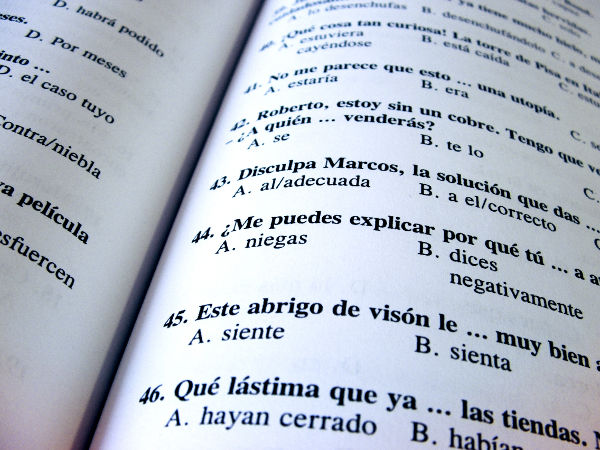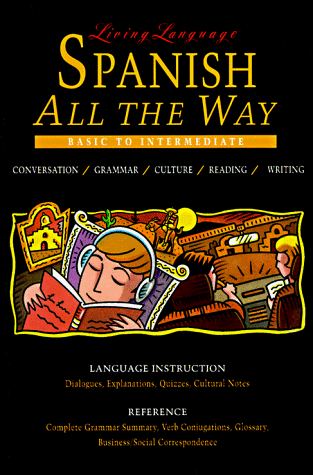Someone at Living Language must have gotten my letter (okay, I didn’t actually send one), because just under the title on the cover of the book it says: “Conversation / Grammar / Culture / Reading / Writing”. How else could they have known just what I wanted? Compared to some of the Living Language courses I have seen in the past, this is a surprisingly satisfying book, but it’s not without its faults. Let’s find out why!
Before starting, I’ll take a moment to break down the basic format that the lessons in the book follow:
·Dialogue (includes English translation directly below)
·Pronunciation (for the earlier lessons)
·Grammar and Usage
·Vocabulary
·“Quiz”
·Culture notes
·Answers to quiz questions
This is a format that I generally find to be most desirable for beginner and intermediate language texts, as it focuses on a communicative approach, with plenty of variety to keep the student interested. The introduction in the book gives a breakdown of each of these sections and what to expect from them, but there is not much in the way of the author’s suggestions for how to use the book. I don’t have the audio for this course (it was originally recorded on cassettes), but I don’t feel like this is particularly important for working through the course in a classroom setting. If you want to track down the cassettes, however, all dialogues are supposedly recorded with two different versions – one for you to follow along with the textbook, and one that presents all the lessons from the textbook with an English speaking instructor so that you don’t need the textbook. With both versions, there’s supposed to be 8 hours of Spanish audio practice, but I can’t say anything to vouch for the quality or usefulness of it, as I haven't used it myself.
The book makes an effort to teach Spanish pronunciation, but it offers little more than a short explanation with a comparison to English sounds. This is somewhat disappointing, but, again, there are more than plenty of other resources to learn Spanish pronunciation.

I feel somewhat conflicted about the dialogues. I like the fact that they are abundant (40 all together), and I like that they are short, cover a variety of topics, and are relatively fun to read. On the other hand, there isn't a consistent narrative throughout the book or reoccurring characters in the dialogues. Most of the dialogues are what I would describe as “task-based” in content, which is not exactly ideal. It can work well for those that are highly self-motivated and mainly looking to “get by” in the language, but may have trouble keeping the attention of other students, as the content itself is not particularly interesting. The English translations immediately following the dialogues are useful, but can sometimes be distracting.
Interestingly enough, the grammar and usage section is presented before vocabulary. Perhaps they thought that the vocabulary wasn’t as important because they put in an English translation. In any case, I am a fan of their grammar and usage explanations. They keep things concise, provide a few examples, and move to the next point. I also felt this book contains more grammar explanations than your average textbook for beginners, which is definitely a positive thing for those looking to learn quickly.
Now, the vocabulary section is really where things broke down with this book. To be quite blunt, it’s absolutely horrible. I don’t understand their reasoning on this section at all, as it doesn’t come directly after the dialogue, and it doesn’t present the vocabulary in order of appearance in the dialogue, or alphabetically. I may have confused you with that sentence, so I’ll say it again: vocabulary is not organized according to the order it appears in the dialogues, nor alphabetically. In other words, the vocabulary section is just a completely random list. It does have the vocabulary from the lesson along with other vocabulary items of the same theme, but there is no organization to this section at all. I looked through each lesson trying to understand why they decided to do things this way, but I couldn’t seem to come up with anything.
"Now, the vocabulary section is really where things broke down with this book. To be quite blunt, it’s absolutely horrible."
The quizzes generally ask you to do things like substitution drills, answer questions, or translate. I don’t really see the reason to call them “quizzes” as opposed to just calling them “exercises”, but I suppose that doesn’t really matter. This section in each lesson isn’t particularly long or comprehensive, but I found it does give students a little practice and allows them to test to see how well they have retained the content up to that point. The answers to the quiz are given after the culture notes.
Culture notes in this book tend to be brief – sometimes no more than one or two sentences. The notes are basically just tidbits about Spanish speaking cultures and communities all over the world, focusing more on insight to aspects of daily life than widespread customs and beliefs. I found them to be generally interesting, though some of them didn’t feel especially enlightening (e.g. “Spain is a relatively safe country.”; “Many Latin American countries are in the tropics and the weather often allows for beach activities all year long.”; “Roads in cities are rather good.”).
In addition to these sections, there are four reading passages spread out through the book – one every ten lessons. They’re nothing special, but I appreciated the extra bit of reading practice they provide. There is a vocabulary list following each one, but again, there is no organization of the terms presented.

In the back of the book you have your standard glossaries, appendixes, and index. Just flipping through the glossary you can see that it is a bit more detailed than what you might expect – more like what you would find in a dictionary than in the back of a language text. I appreciated this extra bit of effort, but I don’t feel like it makes too much of a difference, as you will probably have a dictionary at hand in your language studies anyway.
In the end, I thought this was a pretty worthwhile Spanish text. It’s certainly not perfect, but a motivated student should be able to work through it fairly quickly and move on to a lower-intermediate or intermediate text with a fair bit of confidence. I give it the rating of recommended and suggest using it in conjunction with another beginner course, especially if you can’t get your hands on the audio.
For Teachers: This book would likely best be suited for students interested in doing travel to Spanish-speaking countries, either for business or casual travel.
For Students: One of the best things about this book is that it never gets too difficult (an important factor for maintaining motivation). As a student using this book, I would try to find other books or online materials dealing with related topics, and think about how content from each lesson could be applied to situations in your daily life. With a decently paced course, you could work through the entire book relatively quickly, which would be a giant step on the path to mastering Spanish.





